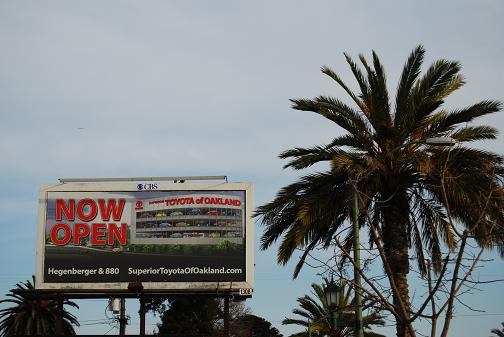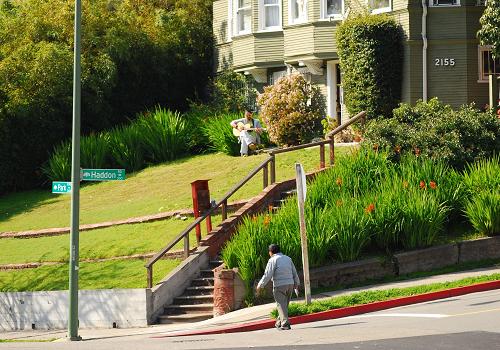This billboard near my home has outlived the business whose opening it was advertising. (The dealership only lasted for two months and closed a few weeks ago. We’ll see how long the billboad lasts.)

This billboard near my home has outlived the business whose opening it was advertising. (The dealership only lasted for two months and closed a few weeks ago. We’ll see how long the billboad lasts.)

I had to go to the Alameda Naval Air Station (more landfill!) for work yesterday, so I brought my camera and used the opportunity to bike around taking some photos before I left the base:
* * *
* * *
* * *
* * *
* * *
Many more are available at my Flickr set. There was a lot that I didn’t get a chance to photograph, so I’ll probably take some more shot next time I’m over at Alameda Point.
An Associated Press dispatch from Sweden:
STOCKHOLM – A canny chimpanzee who calmly collected a stash of rocks and then hurled them at zoo visitors in fits of rage has confirmed that apes can plan ahead just like humans, a Swedish study said Monday. Santino the chimpanzee’s anti-social behavior stunned both visitors and keepers at the Furuvik Zoo but fascinated researchers because it was so carefully prepared.
According to a report in the journal Current Biology, the 31-year-old alpha male started building his weapons cache in the morning before the zoo opened, collecting rocks and knocking out disks from concrete boulders inside his enclosure. He waited until around midday before he unleashed a “hailstorm” of rocks against visitors, the study said.
“Anti-social behavior?” Who locked up whom in a confined space? Further down in the article, we get this:
For a while, zoo keepers tried locking Santino up in the morning so he couldn’t collect ammunition for his assaults, but he remained aggressive. They ultimately decided to castrate him in the autumn last year, but will have to wait until the summer to see if that helps. The chimpanzees are only kept outdoors between April and October and Santino’s special behavior usually occurs in June and July.
“It is normal behavior for alpha males to want to influence their surroundings … It is extremely frustrating for him that there are people out of his reach who are pointing at him and laughing,” Osvath said. “It cannot be good to be so furious all the time.”
Here’s a thought: It also cannot be good to be kept indoors for half of the year! And even chimpanzees, our closest relatives, can probably tell when they’re being laughed at!
I finally got around to reading this Boston Globe article about the selective implementation of the “broken windows” theory of crime in Lowell, Mass. A partnership between some academics and the police department identified 34 crime “hot spots,” then in half of the places they took proactive steps to clean up blight, provide social services, or do more to combat misdemeanors and loitering. In the other half of the high-crime locations, they continued with traditional police techniques (basically doing normal patrols and responding to 911 calls, but nothing preventive or proactive).
The Globe article summarizes the conclusions of the researchers as such:
The results, just now circulating in law enforcement circles, are striking: A 20 percent plunge in calls to police from the parts of town that received extra attention. It is seen as strong scientific evidence that the long-debated “broken windows” theory really works – that disorderly conditions breed bad behavior, and that fixing them can help prevent crime.
Without knowing the details of the study, I’m not so convinced that this “plunge” is so “striking.” While a 20% decline is substantial, it seems predictable that any kind of extra attention given to a crime hot spot will be likely to reduce crime in that particular location — you could assign a few officers to stand at a certain location 24 hours a day, and crime at that spot would “plunge” by close to 100%, but so what? The more important question is which kinds of extra attention accomplish the most good in the most efficient way.
Thankfully, the researchers must have taken steps to isolate certain kinds of “extra attention” from others, and that’s where the more interesting information is. According to the Globe, “the Lowell experiment offers guidance on what seems to work best. Cleaning up the physical environment was very effective; misdemeanor arrests less so, and boosting social services had no apparent impact.” The correlation between the quality of the physical environment and the likelihood of people to commit crimes has also been established by some fascinating experiments in the Netherlands.
Assuming that these findings are valid, they could be very useful for people (and governments) in high-crime areas. Social services, however much they may help in other ways, are probably not an efficient way to reduce crime (sorry, bleeding heart, thug-coddling liberal hippies); zero tolerance for misdemeanors is also probably not a very efficient way to reduce crime (sorry, tough on crime, lock-’em-all-up conservative fascists). If you want bang for your buck, the way to reduce crime the most is to make the place you spend your life prettier — sounds like a win-win situation to me!
Since I live in a medium-crime part of a high-crime city, and since I’m interested in the effects of the urban physical environment for unrelated reasons, I find these studies to be pretty heartening news.
Unlike providing social services or cracking down on misdemeanor crimes, the aesthetics of the physical environment is something that residents of a neighborhood can easily improve without requiring the aid of the police department or city hall. Oakland’s police department is chronically understaffed, plagued by repeated scandals, and led by incompetents or worse, so it is a relief to know that there are ways to combat crime that don’t involve a responsive and accountable police force. Most of Oakland’s elected officials are too busy bickering over parking spaces at City Hall or trying to drive business away from the city to actually get anything useful done, so it is a relief to know that there are ways to combat crime that don’t involve a responsive and fiscally healthy municipal government.
That’s not to say that it’s easy to combat blight in our neighborhoods (it’s hard to get residents to care about anything beyond their own walls, and the collapsing economy is obviously not helpful), but small things such as picking up litter, turning an unsightly patch of dirt into a flower or vegetable garden (whether it be one’s front yard or an abandoned lot down the block), or painting over graffiti on one’s front stoop are not very hard to do, and are probably more effective than trying to get someone from downtown to do something productive in a timely manner.
California’s official motto is “Eureka.” Our official nickname is “The Golden State.” Has any thought has been given to changing one of these to “State of Emergency”?
The most recent state of emergency was proclaimed by Governor Schwarzenegger on Friday, regarding the ongoing drought. (Our current heavy rains, although helpful, have only been a drop in the bucket, so to speak.) Three weeks earlier, the governor had declared a state of emergency because of the state’s projected $42 billion deficit. And every fall, we see numerous states of emergency proclaimed due to wildfires (four separate states of emergency in November alone.) Add to all these the potentially catastrophic emergencies caused by large earthquakes or failure of levees in the Sacramento River Delta, and I can’t help but wonder if “State of Emergency” would be a more apt nickname than “The Golden State.”
Oakland has some venetian gondolas on Lake Merritt, but if you want to find a place in the Bay Area that feels (at least a bit) like Venice, you’ll do better heading across the estuary to Alameda’s lagoons, as I did one day late last week.
Unfortunately, unlike the canals of Venice, Italy (or the canals of Venice, California, for that matter), you won’t have much luck taking a long romantic stroll alongside these lagoons, because there are only a few spots where the public can reach the water’s edge. Most land on the shoreline is private property.
Also unlike the canals of the Venetian archipelago, these lagoons are neither ancient nor natural. In the mid 1950’s Alamedans, showing all the city planning wisdom of that era, voted to allow a developer to add 350 acres of landfill to the tidal flats south of Alameda’s town center, where a new neighborhood and a shopping center would be built (the Alameda Sun’s website has a dramatic but blurry aerial photograph from 1958 showing the new landfill). Stately Victorians on Alameda’s “Gold Coast,” which had previously been on bayfront property, now presided over these small lagoons instead, with views of other homes instead of ships and sailboats out on the bay.
One legacy of this sudden expansion of the island is that you still notice a stark difference in design as soon as you cross over the lagoons to the newer “South Shore” neighborhood. Whereas the older parts of Alameda have narrower 19th-century streets and pedestrian-friendly shopping districts, the more recent development 50 yards away is the epitome of late-50’s planning, with wider roads, numerous cul-de-sacs, drab ranch houses and a sprawling shopping mall. (Continued)
The rain has passed, at least for now, and there was music in the streets again in Oakland yesterday:

Rainfall at Oakland International Airport from January 1st to February 14th: 2.61 inches
Rainfall at Oakland International Airport on February 15th: 1.87 inches
Those two numbers are way below average and way above average, respectively. (In fact, the record rainfall for Feb 15 had previously been 1.41 inches.)
I bought myself a new gadget: I was starting to feel the limitations of my point-and-shoot (only a 3X zoom, for instance), so I upgraded to a Digital SLR. Now I just have to learn how to use it. It’s been raining almost nonstop since I bought it last week, but we finally caught a break in the weather today, so I took it out for a spin:
It does fine as a point-and-shoot with everything set on “auto,” but I assume I’ll get better results if I start paying attention to ISO, aperture, shutter speed, depth of field, and so on. All that is new to me.
I’ll have to learn how to hold the camera flat also, so that the Transamerica Pyramid doesn’t always look like the Leaning Tower of Pisa (the problem is more evident on larger versions of the photo):
I think I found the bluest cargo bay in the world today, on a Warehouse near the Oakland waterfront:
Most of the shots didn’t turn out especially well, and the overcast skies didn’t help, but I did post a couple of others to my Flickr page.